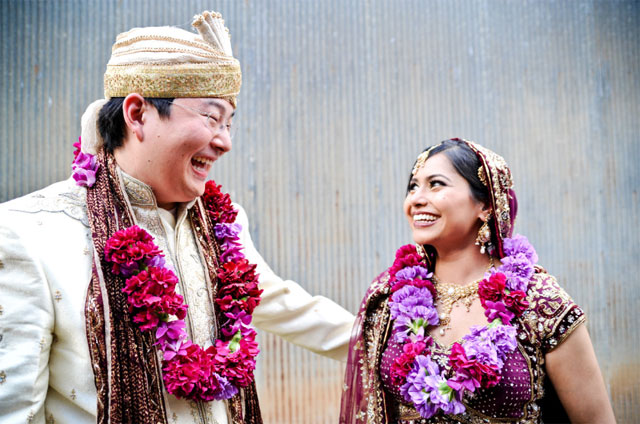How do you make sure every guest understands the wedding without practically having to host two different events? Thankfully, it’s simpler than it sounds. Here’s how The Knot's featured wedding planners get it done.

Find the Right Experts
Hire a wedding planner and photographer who speak both languages. They’ll communicate directly with guests during family portraits and while coordinating formalities, so you want to set them up for success.
Make the Most of Your Wedding Website
A personalized wedding website is an essential tool for every couple, and especially those whose guests speak different languages. With nearly unlimited space, this is where you’ll be able to give your wedding guests all the essential information they need (think: how you met, how to get to the ceremony and reception sites, where to stay and what to wear) in both languages. Use your site to educate your guests about the different cultural traditions and rituals your wedding may include. Your guests won’t be able to help but get excited for your unique bicultural bash.
Make Travel as Easy as Possible
If you’re having a destination wedding or some of your guests have to leave their country to get to your wedding location, recommend or book bilingual accommodations for them. For example, depending on the country, guests may not know that they always need their passport on them, that they should only drink bottled water or they need to adjust their tipping.
Write It All Down
Beyond having a helpful digital wedding hub, make sure your physical paper goods (save-the-dates, invitations, ceremony programs and/or menus) speak to both crowds. Here’s how to get the most out of your stationery and programs:
Stationery
When it comes to your wedding suite, you can either order one design that includes the same message in both languages on the card, or opt for separate sets of invites in each language. It may be cheaper to order only one set in two languages, but if there’s room in your budget to order two sets, having less text per page gives you more design freedom. Custom stationery designers will happily work with you to design a suite that’s aligns with your needs and vision, and places like Minted.com offer beautiful bilingual templates.
Programs
As with your invitations, it’s handy to make your ceremony programs and reception menus bilingual. Besides informing everyone of the basics of your day, programs are perfect to explain and translate cultural readings, songs and cuisine. Keep guests in the know while delighting them with personalized touches—and don’t shy away from adding imagery or decorations from both cultures. Consider your programs and stationery a physical keepsake from your personalized fusion of cultures.
Put Thought Into the Ceremony
The most important, albeit challenging, part of your wedding to translate is the ceremony. You want your aunts from both families to bawl at your vows—but you don’t want every word to be repeated twice. Hiring a bilingual officiant may be the best solution. With your input, a bilingual officiant will know the most meaningful ways to incorporate both languages at different moments while keeping the program seamless and succinct. Remember, while some important phrases, like “you may kiss,” are worth saying twice, not every part of your ceremony needs to be translated and repeated if you don’t want it to be. You might choose to say your vows in English, for example, but then have a loved one say a reading in their native tongue.
Recruit a Bilingual Guest If Possible
Consider recruiting a bilingual relative, wedding party member or willing guest to help anyone who looks lost or has questions during the wedding. This will be especially helpful if you personally don’t speak your partner’s family’s native language.
Incorporate Clever Signage
Fusing two languages is a fun reason to add extra flair to your wedding by setting up signs with directions (we’re talking literal arrows here), day-of run of show instructions and seating charts in both languages. Consider peppering the reception tables with cards with basic conversational phrases in each language, pronunciation tips, explanations of dishes being served or descriptions of foreign traditions.
Keep Speeches Short and Sweet
Anyone up for giving a toast at your wedding should certainly do so in their native language (let’s not make this more complicated than it already is). But encourage reception speakers to be concise so guests don’t zone out during a 10-minute speech they can’t understand. Another smart trick is to alternate speeches in different languages to keep everyone engaged.
Celebrate Cultural Differences
Sometimes, the best way to understand another language isn’t through words, but through the senses and body language—aka food, music and dance. Take advantage of each family’s unique background by infusing your menu and reception entertainment with their rich cultures. Your relatives will love to see their culture live on, and your guests will love to learn more about where you come from.

Ultimately, don’t lose sleep trying to devour the details of your wedding in two (or more) languages. Your guests are smart and will definitely be able to follow the flow of the crowd. And most importantly, the best parts of a wedding—the hugs, smiles and happy tears—need no translation.
No comments:
Post a Comment